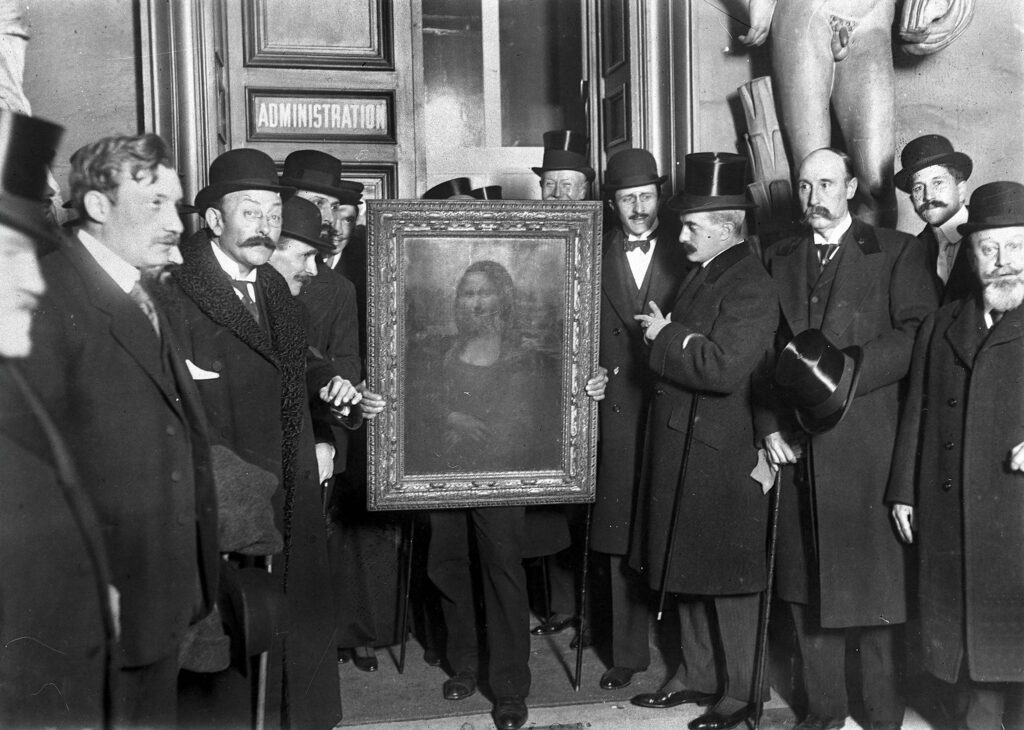On this day in 1911, in what remains one of the most audacious art thefts of the 20th century, Vincenzo Peruggia, a former employee of the Louvre, walked out of the famed museum with Leonardo da Vinci’s Mona Lisa hidden under his arm.
Peruggia, familiar with the museum’s workings due to his prior employment, entered the Louvre early in the morning, blending in with other workers by donning the white smock typically worn by museum staff. He waited for the right moment when the Salon Carré, where the Mona Lisa was displayed, was empty. Seizing the opportunity, Peruggia deftly lifted the painting from its place between Correggio’s Mystical Marriage and Titian’s Allegory of Alfonso d’Avalos. He then made his way to a nearby service stairway, removed the painting from its protective case and frame, and hid the discarded elements behind some student artworks. Contrary to some reports that claimed Peruggia concealed the painting under his smock, it was too large for that. Instead, he wrapped it in his smock, tucked it under his arm, and exited the museum as unassumingly as he had entered.
The theft sent shockwaves throughout France and beyond, with many struggling to comprehend how such a daring crime could occur. Theories about the painting’s disappearance ran wild. Some believed it was the work of professional thieves, while others speculated that it was a German plot to embarrass France. However, the police and investigators were left with no solid leads. Despite interviewing Louvre staff and external workers, including Peruggia himself, no one was able to identify him as the perpetrator.
For over two years, the Mona Lisa remained hidden in a trunk in Peruggia’s Paris apartment. During this time, the police were no closer to recovering the painting. It wasn’t until November 1913 that a breakthrough occurred. Alfredo Geri, an Italian art dealer, received a letter from a man who called himself “Leonardo,” claiming that the painting was in Florence and offering to return it for a hefty ransom. Geri, intrigued yet cautious, contacted the director of the Uffizi Gallery, Giovanni Poggi, who authenticated the painting when it was presented to them by Peruggia. Pretending to need time for safekeeping, Geri and Poggi alerted the authorities, who quickly arrested Peruggia at his hotel.

Peruggia’s motives for the theft remain a subject of debate. During his interrogation, he claimed that his actions were driven by patriotism, wanting to return the painting to Italy, which he believed had been wrongfully taken by Napoleon. However, many experts question this narrative, arguing that if patriotism were his true motive, Peruggia would have donated the painting to an Italian museum rather than seek a ransom. Letters he sent to his father after the theft hint at financial motives, with references to “making his fortune” in Paris.
Nevertheless, when Peruggia was put on trial, the court showed some leniency, partly accepting his patriotic justification. He was sentenced to one year and 15 days in prison but only served seven months. Upon his release, he returned to Italy, where he was hailed by some as a national hero.
In the years following the theft, another theory emerged, suggesting that Peruggia may have been acting on behalf of Eduardo de Valfierno, a notorious con man. According to a 1932 article by journalist Karl Decker, Valfierno had commissioned a forger to create copies of the Mona Lisa, intending to sell them as the stolen original. The theft would have increased the value of the forgeries. However, this theory lacks concrete evidence and is based solely on Decker’s account.
Ultimately, the Mona Lisa was returned to the Louvre in 1913, where it remains to this day. While the painting was already famous before the theft, the incident propelled it to global stardom, making it one of the most recognized and celebrated artworks in the world. The Louvre, in response to the theft, significantly improved its security measures to protect its priceless collection, ensuring that such a theft would never happen again.












